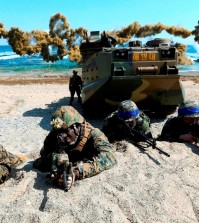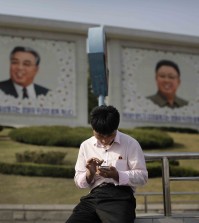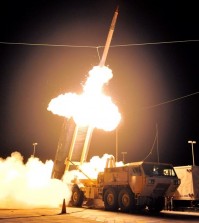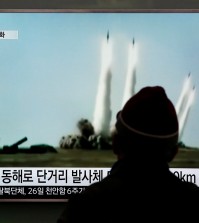- California Assembly OKs highest minimum wage in nation
- S. Korea unveils first graphic cigarette warnings
- US joins with South Korea, Japan in bid to deter North Korea
- LPGA golfer Chun In-gee finally back in action
- S. Korea won’t be top seed in final World Cup qualification round
- US men’s soccer misses 2nd straight Olympics
- US back on track in qualifying with 4-0 win over Guatemala
- High-intensity workout injuries spawn cottage industry
- CDC expands range of Zika mosquitoes into parts of Northeast
- Who knew? ‘The Walking Dead’ is helping families connect
North Korea conducts live fire drills near NLL
North Korea conducted a live-fire drill near the Northern Limit Line (NLL), the Joint Chiefs of Staff (JCS) said Tuesday.
“The firing began at 2 p.m., hours after it delivered a notification,” JCS spokesman Eom Hyo-sik said. Air Force F-15 jets were scrambled for surveillance operations, while the military was put on alert.
The North fired more than 50 artillery shells for more than 10 minutes, but no rounds landed south of the maritime border, he said. The rounds dropped about 3 kilometers north of the NLL.
Residents of five northwestern border islands including Yeonpyeong and Baengnyeong, which lie just south of the NLL, were evacuated to shelters, the JSC said.
Fishing vessels were also warned not to enter the area — an order that was lifted at 3:30 p.m.
In addition, the military strengthened its readiness by dispatching warships and early warning surveillance aircraft, as well as fighter jets, near the area to prepare for a potential clash.
The live-fire exercise took place one month after the two Koreas traded more than 800 artillery shells and rockets after about 100 of 500 shells fired from the North landed south of the NLL.
Earlier in the day, the Southwestern Command of the Korean People’s Army faxed the South Korean Navy’s Second Fleet at 8:52 a.m. to notify it of the drills in two border regions.
In response, the JCS warned the North to keep its drills north of the NLL, or otherwise, the South would take strong countermeasures.
President Park Geun-hye ordered the military to respond by principle should North Korean artillery shells violate the sea border.
The South’s defense ministry called the live-fire drill “quite provocative.”
“The North’s conducting a shelling drill toward southern waters implies its provocative nature,” ministry spokesman Kim Min-seok said in a briefing that took place ahead of the exercise.
“We are carefully monitoring North Korea to sternly react if any of its shells fall in southern waters.”
The exercise comes after the North made lewd remarks about President Park after last week’s South Korea-U.S. summit in Seoul.
The North’s Committee for the Peaceful Reunification of Korea released a statement on Sunday in which it called Park a “capricious whore who asks her fancy man to do harm to another person while providing sex for him.”
On Monday, the National Defense Commission, the North’s most powerful body, warned the U.S. of a possible nuclear test or intercontinental ballistic missile launch, criticizing U.S. President Barack Obama who said that threats would get North Korea nothing, other than greater isolation.
Pyongyang watchers said that the North’s live-fire drill is a low-intensity show of force against the summit.
“It is an expression of disappointment against the summit between South Korea and the U.S.,” said Yang Moo-jin, a political scientist at the University of North Korean Studies.
In the summit, the two state leaders agreed to refuse to accept a nuclear North Korea.
There is speculation that the reclusive state may carry out the launch of a long-range missile or conduct a fourth nuclear test following the live-fire drill.
Yang said that it depends on follow-up measures by the South and the U.S.
“If South Korea and the U.S. press North Korea because of the live-fire drill, the North may go further,” he said.
















